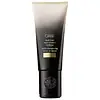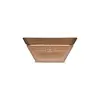What's inside
What's inside
 Key Ingredients
Key Ingredients

No key ingredients
 Benefits
Benefits

 Concerns
Concerns

 Ingredients Side-by-side
Ingredients Side-by-side

Water
Skin ConditioningCetearyl Alcohol
EmollientBehentrimonium Chloride
PreservativeDimethicone
EmollientCetyl Alcohol
EmollientStearamidopropyl Dimethylamine
EmulsifyingAmodimethicone
Hydrogenated Ethylhexyl Olivate
EmollientCetyl Esters
EmollientPropanediol
SolventParfum
MaskingPolysorbate 60
EmulsifyingGuar Hydroxypropyltrimonium Chloride
Skin ConditioningButyrospermum Parkii Butter
Skin ConditioningDimethiconol
EmollientHydrogenated Olive Oil Unsaponifiables
EmollientHydroxyethylcellulose
Emulsion StabilisingPanthenol
Skin ConditioningGlycerin
HumectantDisodium EDTA
C11-15 Pareth-7
EmulsifyingLaureth-9
EmulsifyingCetrimonium Chloride
AntimicrobialTrideceth-15
EmulsifyingTrideceth-3
EmulsifyingPentaerythrityl Tetra-Di-T-Butyl Hydroxyhydrocinnamate
AntioxidantBHT
AntioxidantTrideceth-12
EmulsifyingPolysilicone-15
UV FilterJojoba Esters
EmollientQuaternium-95
UV AbsorberAcetic Acid
BufferingAdansonia Digitata Seed Oil
EmollientArgania Spinosa Kernel Oil
EmollientCaffeine
Skin ConditioningButylene Glycol
HumectantMoringa Oleifera Seed Oil
EmollientAlcohol
AntimicrobialCamellia Sinensis Leaf Extract
AntimicrobialChondrus Crispus Extract
Skin ConditioningCitrus Limon Fruit Extract
MaskingJasminum Officinale Flower Extract
MaskingPassiflora Incarnata Extract
AstringentRibes Nigrum Fruit Extract
AstringentCystine Bis-Pg-Propyl Silanetriol
Skin ConditioningHydrolyzed Vegetable Protein Pg-Propyl Silanetriol
Skin ConditioningHydrolyzed Vegetable Protein
Skin ConditioningBromelain
Skin ConditioningCitrus Aurantium Bergamia Leaf Extract
AstringentLeontopodium Alpinum Extract
Skin ConditioningNiacinamide
SmoothingSantalum Album Extract
CleansingAmber Extract
Skin ConditioningCitrullus Lanatus Fruit Extract
Skin ConditioningTocopherol
AntioxidantVegetable Amino Acids
Skin ConditioningCupressus Sempervirens Seed Extract
PerfumingOryza Sativa Seed Protein
AntioxidantLeuconostoc/Radish Root Ferment Filtrate
AntimicrobialPhytic Acid
Oryza Sativa Extract
AbsorbentCitrulline
Skin ConditioningGluconolactone
Skin ConditioningBiotin
AntiseborrhoeicTocopheryl Acetate
AntioxidantLitchi Chinensis Pericarp Extract
Skin ConditioningMoringa Oleifera Seed Extract
Skin ConditioningCalcium Gluconate
HumectantSodium Phosphate
BufferingDisodium Phosphate
BufferingBenzyl Alcohol
PerfumingEthylhexylglycerin
Skin ConditioningPhenoxyethanol
PreservativeCaprylyl Glycol
EmollientIsopropyl Alcohol
SolventPotassium Sorbate
PreservativeChlorphenesin
AntimicrobialSodium Benzoate
MaskingCitric Acid
BufferingLimonene
PerfumingHexyl Cinnamal
PerfumingWater, Cetearyl Alcohol, Behentrimonium Chloride, Dimethicone, Cetyl Alcohol, Stearamidopropyl Dimethylamine, Amodimethicone, Hydrogenated Ethylhexyl Olivate, Cetyl Esters, Propanediol, Parfum, Polysorbate 60, Guar Hydroxypropyltrimonium Chloride, Butyrospermum Parkii Butter, Dimethiconol, Hydrogenated Olive Oil Unsaponifiables, Hydroxyethylcellulose, Panthenol, Glycerin, Disodium EDTA, C11-15 Pareth-7, Laureth-9, Cetrimonium Chloride, Trideceth-15, Trideceth-3, Pentaerythrityl Tetra-Di-T-Butyl Hydroxyhydrocinnamate, BHT, Trideceth-12, Polysilicone-15, Jojoba Esters, Quaternium-95, Acetic Acid, Adansonia Digitata Seed Oil, Argania Spinosa Kernel Oil, Caffeine, Butylene Glycol, Moringa Oleifera Seed Oil, Alcohol, Camellia Sinensis Leaf Extract, Chondrus Crispus Extract, Citrus Limon Fruit Extract, Jasminum Officinale Flower Extract, Passiflora Incarnata Extract, Ribes Nigrum Fruit Extract, Cystine Bis-Pg-Propyl Silanetriol, Hydrolyzed Vegetable Protein Pg-Propyl Silanetriol, Hydrolyzed Vegetable Protein, Bromelain, Citrus Aurantium Bergamia Leaf Extract, Leontopodium Alpinum Extract, Niacinamide, Santalum Album Extract, Amber Extract, Citrullus Lanatus Fruit Extract, Tocopherol, Vegetable Amino Acids, Cupressus Sempervirens Seed Extract, Oryza Sativa Seed Protein, Leuconostoc/Radish Root Ferment Filtrate, Phytic Acid, Oryza Sativa Extract, Citrulline, Gluconolactone, Biotin, Tocopheryl Acetate, Litchi Chinensis Pericarp Extract, Moringa Oleifera Seed Extract, Calcium Gluconate, Sodium Phosphate, Disodium Phosphate, Benzyl Alcohol, Ethylhexylglycerin, Phenoxyethanol, Caprylyl Glycol, Isopropyl Alcohol, Potassium Sorbate, Chlorphenesin, Sodium Benzoate, Citric Acid, Limonene, Hexyl Cinnamal
Water
Skin ConditioningStearyl Alcohol
EmollientGlycerin
HumectantBehentrimonium Chloride
PreservativeCetyl Esters
EmollientTrimethylolpropane Tricaprylate/Tricaprate
EmollientCetyl Alcohol
EmollientSalvia Hispanica Seed Extract
EmollientGlyceryl Dilaurate
EmollientCarthamus Tinctorius Seed Oil
MaskingHydrolyzed Carrot Protein/Hydrolyzed Kale Protein/Hydrolyzed Lemon Protein Extract
Helianthus Annuus Seed Extract
Skin ConditioningAloe Barbadensis Leaf Juice
Skin ConditioningGlyceryl Stearate Se
EmulsifyingCetrimonium Chloride
AntimicrobialIsopropyl Alcohol
SolventPhenoxyethanol
PreservativeEthylhexylglycerin
Skin ConditioningCitric Acid
BufferingParfum
MaskingWater, Stearyl Alcohol, Glycerin, Behentrimonium Chloride, Cetyl Esters, Trimethylolpropane Tricaprylate/Tricaprate, Cetyl Alcohol, Salvia Hispanica Seed Extract, Glyceryl Dilaurate, Carthamus Tinctorius Seed Oil, Hydrolyzed Carrot Protein/Hydrolyzed Kale Protein/Hydrolyzed Lemon Protein Extract, Helianthus Annuus Seed Extract, Aloe Barbadensis Leaf Juice, Glyceryl Stearate Se, Cetrimonium Chloride, Isopropyl Alcohol, Phenoxyethanol, Ethylhexylglycerin, Citric Acid, Parfum
Ingredients Explained
These ingredients are found in both products.
Ingredients higher up in an ingredient list are typically present in a larger amount.
This ingredient is a preservative and often used for it's anti-static properties. You'll most likely see this ingredient in hair conditioners.
It does not cause irritation or sensitization in leave-on products at 1-5%.
This ingredient is a preservative, antimicrobial, and emulsifier. It is often used in cosmetics for its ability to cleanse, condition, and reduce static.
Cetrimonium chloride is a quaternary ammonium salt, meaning it has a water-soluble structure.
Cetyl Alcohol is a fatty alcohol. Fatty Alcohols are most often used as an emollient or to thicken a product.
Its main roles are:
Though it has "alcohol" in the name, it is not related to denatured alcohol or ethyl alcohol.
The FDA allows products labeled "alcohol-free" to have fatty alcohols.
Learn more about Cetyl AlcoholCetyl Esters is a synthetic wax made up of mostly fatty acids and fatty alcohols. It is strcturally similar to wax taken from whales.
As an emollient, it creates a thin barrier on the skin. This barrier prevents moisture from escaping.
This ingredient may not be fungal-acne safe.
Learn more about Cetyl EstersCitric Acid is an alpha hydroxy acid (AHA) naturally found in citrus fruits like oranges, lemons, and limes.
Like other AHAs, citric acid can exfoliate skin by breaking down the bonds that hold dead skin cells together. This helps reveal smoother and brighter skin underneath.
However, this exfoliating effect only happens at high concentrations (20%) which can be hard to find in cosmetic products.
Due to this, citric acid is usually included in small amounts as a pH adjuster. This helps keep products slightly more acidic and compatible with skin's natural pH.
In skincare formulas, citric acid can:
While it can provide some skin benefits, research shows lactic acid and glycolic acid are generally more effective and less irritating exfoliants.
Most citric acid used in skincare today is made by fermenting sugars (usually from molasses). This synthetic version is identical to the natural citrus form but easier to stabilize and use in formulations.
Read more about some other popular AHA's here:
Learn more about Citric AcidEthylhexylglycerin (we can't pronounce this either) is commonly used as a preservative and skin softener. It is derived from glyceryl.
You might see Ethylhexylglycerin often paired with other preservatives such as phenoxyethanol. Ethylhexylglycerin has been found to increase the effectiveness of these other preservatives.
Glycerin is already naturally found in your skin. It helps moisturize and protect your skin.
A study from 2016 found glycerin to be more effective as a humectant than AHAs and hyaluronic acid.
As a humectant, it helps the skin stay hydrated by pulling moisture to your skin. The low molecular weight of glycerin allows it to pull moisture into the deeper layers of your skin.
Hydrated skin improves your skin barrier; Your skin barrier helps protect against irritants and bacteria.
Glycerin has also been found to have antimicrobial and antiviral properties. Due to these properties, glycerin is often used in wound and burn treatments.
In cosmetics, glycerin is usually derived from plants such as soybean or palm. However, it can also be sourced from animals, such as tallow or animal fat.
This ingredient is organic, colorless, odorless, and non-toxic.
Glycerin is the name for this ingredient in American English. British English uses Glycerol/Glycerine.
Learn more about GlycerinIsopropyl Alcohol is more commonly known as rubbing alcohol. It is most commonly used as a solvent, meaning it helps other ingredients dissolve.
This ingredient is an astringent alcohol. Astringent alcohols may also irritate skin as they high amounts may strip away your skin's natural oils.
Other types of astringent alcohols include:
According to the National Rosacea Society based in the US, you should be mindful of products with these alcohols in the top half of ingredients.
Any type of sanitizing product will have high amounts of alcohol to help kill bacteria and viruses.
Learn more about Isopropyl AlcoholParfum is a catch-all term for an ingredient or more that is used to give a scent to products.
Also called "fragrance", this ingredient can be a blend of hundreds of chemicals or plant oils. This means every product with "fragrance" or "parfum" in the ingredients list is a different mixture.
For instance, Habanolide is a proprietary trade name for a specific aroma chemical. When used as a fragrance ingredient in cosmetics, most aroma chemicals fall under the broad labeling category of “FRAGRANCE” or “PARFUM” according to EU and US regulations.
The term 'parfum' or 'fragrance' is not regulated in many countries. In many cases, it is up to the brand to define this term.
For instance, many brands choose to label themselves as "fragrance-free" because they are not using synthetic fragrances. However, their products may still contain ingredients such as essential oils that are considered a fragrance by INCI standards.
One example is Calendula flower extract. Calendula is an essential oil that still imparts a scent or 'fragrance'.
Depending on the blend, the ingredients in the mixture can cause allergies and sensitivities on the skin. Some ingredients that are known EU allergens include linalool and citronellol.
Parfum can also be used to mask or cover an unpleasant scent.
The bottom line is: not all fragrances/parfum/ingredients are created equally. If you are worried about fragrances, we recommend taking a closer look at an ingredient. And of course, we always recommend speaking with a professional.
Learn more about ParfumPhenoxyethanol is a preservative that has germicide, antimicrobial, and aromatic properties. Studies show that phenoxyethanol can prevent microbial growth. By itself, it has a scent that is similar to that of a rose.
It's often used in formulations along with Caprylyl Glycol to preserve the shelf life of products.
Water. It's the most common cosmetic ingredient of all. You'll usually see it at the top of ingredient lists, meaning that it makes up the largest part of the product.
So why is it so popular? Water most often acts as a solvent - this means that it helps dissolve other ingredients into the formulation.
You'll also recognize water as that liquid we all need to stay alive. If you see this, drink a glass of water. Stay hydrated!
Learn more about Water